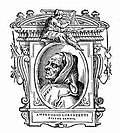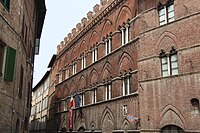File:Ambrogio Lorenzetti Dorotea from Madonna and Child with Magdalene Dorothea.jpg

Original file (303 × 633 pixels, file size: 167 KB, MIME type: image/jpeg)
Captions
Captions
| Ambrogio Lorenzetti: Detail from Madonna and Child with Mary Magdalene and St Dorothea
( |
||||||||||||||||||||||||
|---|---|---|---|---|---|---|---|---|---|---|---|---|---|---|---|---|---|---|---|---|---|---|---|---|
| Artist |
artist QS:P170,Q211562 |
|||||||||||||||||||||||
| Title |
Detail from Madonna and Child with Mary Magdalene and St Dorothea |
|||||||||||||||||||||||
| Date |
circa 1325 date QS:P571,+1325-00-00T00:00:00Z/9,P1480,Q5727902 |
|||||||||||||||||||||||
| Medium |
wood medium QS:P186,Q287 |
|||||||||||||||||||||||
| Collection |
institution QS:P195,Q2095405 |
|||||||||||||||||||||||
| Source/Photographer | file:Ambrogio Lorenzetti - Madonna and Child with Mary Magdalene and St Dorothea - WGA13467.jpg | |||||||||||||||||||||||
| Permission (Reusing this file) |
|
|||||||||||||||||||||||
| Other versions |
Derivated from  |
|||||||||||||||||||||||
File history
Click on a date/time to view the file as it appeared at that time.
| Date/Time | Thumbnail | Dimensions | User | Comment | |
|---|---|---|---|---|---|
| current | 16:45, 15 June 2013 |  | 303 × 633 (167 KB) | Amadalvarez (talk | contribs) | {{Artwork |artist = {{Creator:Ambrogio Lorenzetti}} |title = Detail from Madonna and Child with Mary Magdalene and St Dorothea |description = |date = {{other date|ca|1325}} |medi... |
You cannot overwrite this file.
File usage on Commons
The following page uses this file:
File usage on other wikis
The following other wikis use this file:
- Usage on ca.wikipedia.org
- Usage on ru.wikipedia.org
Metadata
This file contains additional information such as Exif metadata which may have been added by the digital camera, scanner, or software program used to create or digitize it. If the file has been modified from its original state, some details such as the timestamp may not fully reflect those of the original file. The timestamp is only as accurate as the clock in the camera, and it may be completely wrong.
| JPEG file comment | LORENZETTI, Ambrogio
(b. ca. 1290, Siena, d. 1348, Siena) Madonna and Child with Mary Magdalene and St Dorothea c. 1325 Wood, 90 x 53 cm (central panel), 88 x 39 cm (side panels, each) Pinacoteca Nazionale, Siena The three paintings were originally in the church of the former convent of Santa Petronilla in Siena (originally it was the church of the Umiliati), and they have been recomposed into a triptych in the Siena Pinacoteca. Their provenance justifies the scroll held by the Child: "beati pauperes", blessed be ye poor, for yours is the kingdom of God (Luke, 6:20). The Child lovingly has one arm around his mother's neck, while the Virgin holds her face next to the Child's, gazing at him with an intense and penetrating look. It is this look of Mary's, fully aware and in sorrow for she already knows of the Saviour's Passion and the grief that awaits them both, that is the entirely new and original feature of Ambrogio's paintings of the subject of the Madonna and Child; and he devotes a great deal of attention to this expression. The two saints at the sides, Mary Magdalene to the left and St Dorothea to the right, participate in this moment of deep intimacy with their calm gestures. In the Middle Ages there was a great deal of confusion between several different female characters and they were frequently blended into one person: one is the nameless woman sinner who spread ointment over Christ's feet in the house of the Pharisee and was pardoned precisely because of her great love for Christ, whose feet she had washed with her tears, and kissed and dried with her hair (Luke, 7:36-46); another is Mary Magdalene, possessed by the evil spirits and healed by Christ (Luke, 8:2), who was the first to see him after the Resurrection (Mark, 16:9); and lastly, Mary of Bethany, the sister of Martha and Lazarus, who foresees the imminent death of Christ and pours a precious ointment on his head during the feast in Bethany (Matthew, 26:6-13). Lorenzetti, too, blends together these different characters: Mary Magdalene holds in her hand a precious ointment pot and, because of her beauty and red dress, she is probably the blonde sinner Christ saw in the house of the Pharisee; but on her breast we see the bleeding face of the crucified Christ, which is the dramatic foreboding that Martha's sister had in Bethany, although it is placed on the heart, to symbolize, once again, the great love shown by the sinner. On the other side, St Dorothea, with her lap full of flowers, offers a bunch of flowers while looking at the Christ Child in a serious and intense way: this is a reference to the culminating moment of her story, when while she is being led off to her martyrdom she meets the unbelieving Theophilus, who asks her to send him flowers and fruit from the garden of Paradise. The saint then concentrates in prayer and just before she is decapitated a child (the Christ Child) appears to her, bearing a basket of flowers and fruit which will succeed in converting Thephilus. In the triptych both the saints continue with the sorrowful meditations of the Virgin; Mary Magdalene shows the Man of Sorrows on her heart and the pot of ointment, in memory of the one she took to the already empty sepulchre; Dorothea, on the other hand, who is looking straight at Jesus, is showing him the bunch of flowers, the symbol of her martyrdom and of the gardens of Paradise where the Saviour is waiting for her. Christ's earthly life is recounted in the splendid predella containing the Lamentation over the Dead Christ.
Author: LORENZETTI, Ambrogio Title: Madonna and Child with Mary Magdalene and St Dorothea Time-line: 1301-1350 School: Italian Form: painting Type: religious |
|---|

